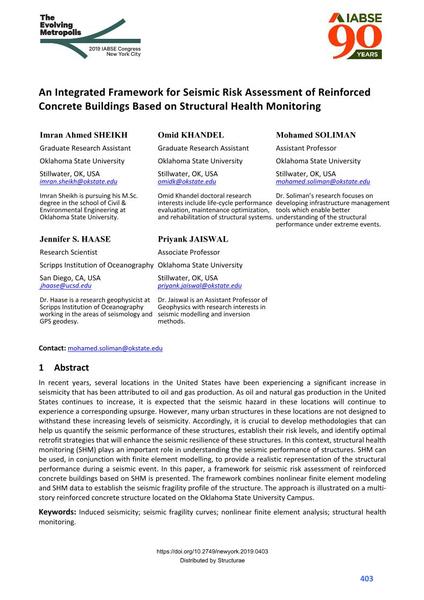An Integrated Framework for Seismic Risk Assessment of Reinforced Concrete Buildings Based on Structural Health Monitoring

|
|
|||||||||||
Détails bibliographiques
| Auteur(s): |
Imran Ahmed Sheikh
(Oklahoma State University)
Omid Khandel Mohamed Soliman Jennifer S. Haase (Scripps Institution of Oceanography) Priyank Jaiswal (Oklahoma State University) |
||||
|---|---|---|---|---|---|
| Médium: | papier de conférence | ||||
| Langue(s): | anglais | ||||
| Conférence: | IABSE Congress: The Evolving Metropolis, New York, NY, USA, 4-6 September 2019 | ||||
| Publié dans: | The Evolving Metropolis | ||||
|
|||||
| Page(s): | 403-408 | ||||
| Nombre total de pages (du PDF): | 6 | ||||
| DOI: | 10.2749/newyork.2019.0403 | ||||
| Abstrait: |
In recent years, several locations in the United States have been experiencing a significant increase in seismicity that has been attributed to oil and gas production. As oil and natural gas production in the United States continues to increase, it is expected that the seismic hazard in these locations will continue to experience a corresponding upsurge. However, many urban structures in these locations are not designed to withstand these increasing levels of seismicity. Accordingly, it is crucial to develop methodologies that can help us quantify the seismic performance of these structures, establish their risk levels, and identify optimal retrofit strategies that will enhance the seismic resilience of these structures. In this context, structural health monitoring (SHM) plays an important role in understanding the seismic performance of structures. SHM can be used, in conjunction with finite element modelling, to provide a realistic representation of the structural performance during a seismic event. In this paper, a framework for seismic risk assessment of reinforced concrete buildings based on SHM is presented. The framework combines nonlinear finite element modeling and SHM data to establish the seismic fragility profile of the structure. The approach is illustrated on a multi- story reinforced concrete structure located on the Oklahoma State University Campus. |
||||
